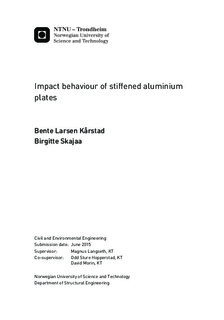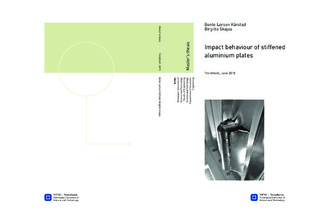| dc.description.abstract | In this master thesis, impact loading against stiffened aluminium plates of the aluminium alloy AA6082-T6 was studied. The main objective was to study the behaviour of extruded aluminium profiles welded together when exposed to impact loading from a ship, and how to model it in a large scale analysis. The study was part of a cooperation between SIMLab at NTNU, Hydro Aluminium and Sapa, as a part of the project Coastal Highway Route E39 .
Eight plates were tested in the laboratory experiment, four by applying quasi-static loading and four by applying dynamic loading, with a cylindrical indenter in the centre of the plate, transversal and longitudinal to the stiffeners. The dynamic experiments were conducted using the kicking machine at the Department of Structural Engineering, NTNU. The experiments were attempted simulated and validated using shell elements in a nonlinear element analysis in Abaqus/Explicit. In order to perform the laboratory experiments, a rig fixing the aluminium plates in the test machine was designed.
In the experiments a good correlation was detected between the quasi-static and dynamic tests. This gave grounds to conclude that quasi-static experiments could give satisfying validation for this type of experiment on the aluminium alloy, AA6082-T6.
The numerical model was implemented with two different criteria to detect fracture, the Cockcroft-Latham (CL) fracture criterion and the Bressan-Williams-Hill (BWH) instability criterion. The material implementation was simplified by using the von Mises yield criterion, where the anisotropic properties of the AA6082-T6 were neglected. The CL fracture criterion gave acceptable estimates of initiation of fracture when the mesh size is equal to the thickness of the plate. With a coarser mesh, the accuracy of this criterion decreased significantly. The BWH instability criterion gave acceptable estimates of initiation of fracture for mesh sizes varying from equal to the thickness to five times the thickness. The estimates showed to be somewhat conservative for this criterion, and a slight mesh sensitivity was detected.
In the material tests, a large degree of anisotropy was detected for aluminium alloy AA6082-T6, and a large difference between the material properties in the plate, stiffeners and the friction stir welds was found. This made the material implementation more complicated than first assumed, and the simplification with an isotropic yield criterion less accurate. An anisotropic yield criterion would more accurately describe the material behavior in the experiments, and could therefore give improved estimates. | |

